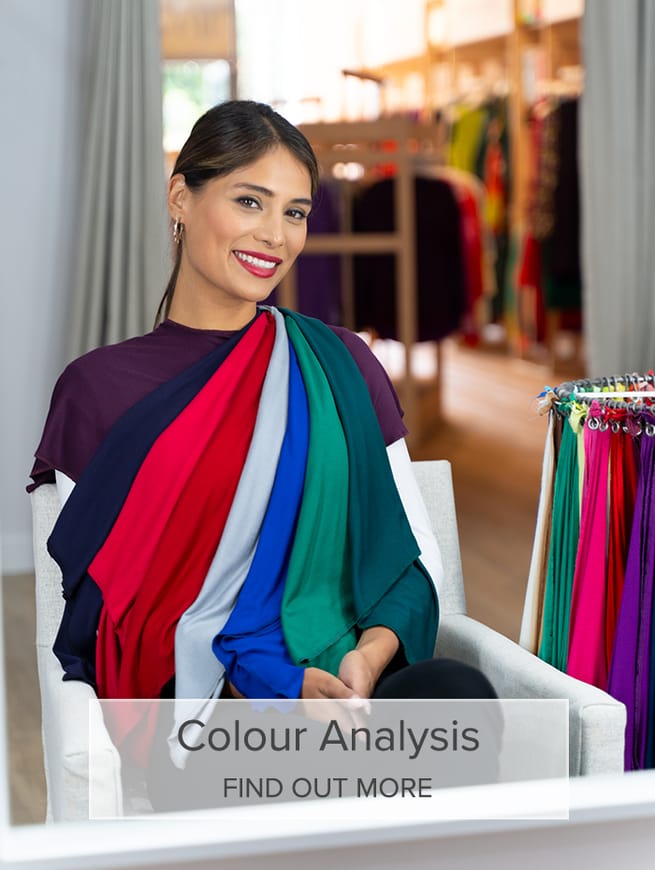The Different Seasonal Sub-Types of Winters


Seasonal subtypes bring a deeper level of precision to colour analysis. While the four main seasons – Spring, Summer, Autumn and Winter – set the foundation based on warm or cool undertones, sub-types pinpoint which part of the palette works for your unique colouring. Do remember, though, that your seasonal subtype is a guide. If you fall at one end of a palette, it doesn’t mean you can never go near colours from other areas of that palette – just that this particular area is the strongest for your individual skin tone and contrast level.
The Winter Seasonal Colour Palette Explained
The Winter palette is cool, clear, saturated and high contrast. It contains everything from icy turquoise to jewel bright fuchsia, through to stark black and white. Knowing your seasonal sub-type means knowing which colours from your wider palette will work best for you, and give you guidance on the best way for you to combine colours to feel your most authentic, confident self.
Let’s explore the sub-types within the Winter palette, and discover how knowing your sub-type can open up even more amazing colours for you.
Do remember that your seasonal type is a guide. It doesn’t mean you can’t ever go near colours from other areas of the Winter palette, just that this particular area is the very best part for your own skin tone and contrast level. Remember that all of the colours within your wider seasonal palette will also work for you, and will harmonise with your sub-type ‘wow’ colours.
The True Winter Seasonal Colour Palette Explained
This is the classic Winter palette, also known as Jewel Winter. The True Winter person (and their palette) has an even balance of Winters cool, clear and high contrast characteristics
True Winters often (although definitely not always!) look like the ‘classic’ Winter - they can have very dark hair, fair skin and bright eyes. Their skin can be any colour, but that feeling of contrast generally remains - either between hair and skin tone, or between skin/hairs and bright whites of eyes and teeth.
Because you sit right in the middle of the Winter palette - there is no ‘leaning’ towards any of the other three seasons, by being deeper, softer, warmer or cooler - the best colours for these True Winters really are, very simply, the colours of the Winter palette! Cheating on your palette by shopping from colours in another palette is never going to work as well for you as one of the other types of Winter, who can push into their neighbouring season. The flip side is that you look the best in the widest range of Winter colours, as you really do sit bang in the middle of this palette. This means that it isn’t often helpful to add a tonal direction to the shopping filter on the Shop by Colour page, as adding in colours from other seasons rarely helps you - simply choose from the full Winter palette and you’ll never go far wrong!
You still have your own very best core of colours though. They are, unsurprisingly, the most definitively Winter colours. They can be any shade, from fuchsia pink to emerald green and black and white, but they all share the characteristics of coolness, contrast and brightness that you also hold.
When it comes to colour combining, you generally do high contrast within your outfit incredibly well - either pairing a neutral and a bright, or two or more brights within your outfit. If your outfits feel a little flat, adding in some more contrast between colours or levels of light and dark within your outfit can bring you back to your bold Winter self!
The Bright Winter Seasonal Colour Palette Explained
Also known as a Sprinter Winter, the most dominant characteristic of Bright Winters is the clarity and brightness of their look, more than the coolness or contrast (which they also hold, but to a lesser degree).
Bright Winters very often look like they might be Springs, with lighter brown or blonde hair and bright blue eyes. They can have any skintone and hair colour though, and the dominant characteristic is that brightness in the eyes and skin when flattered with their best colours.
Bright Winter falls at the less cool toned end of the Winter palette, and if you viewed all four seasons as one continuous spectrum of colour, then Bright Winter’s colours would fall nearer to Spring than to Summer or Autumn.
Bright Winter’s best colours are usually clear, bright blues, bright neon pinks, and true reds, as well as icy colours.
You will almost certainly look your best with a good degree of contrast within your outfit - mix light and dark tones, as well as unexpected colour combinations, for a high contrast look that will highlight the contrast and brightness within your own features.
The dominant tonal direction for this seasonal sub-type is Clear, so you can visit Shop by Colour and filter for the Clear dominant tonal direction for more colours which you might love (if you want to read more about how tonal directions relate to seasons, this post is a great starting point).
The Cool Winter Seasonal Colour Palette Explained

Also known as a Sultry Winter, the most noticeable characteristic of Cool Winters is the coolness in their skin, hair and eye colour, although this still retain Winter’s clear and (very often also noticeable) deep traits too.
Cool Winters can have almost any colouring, although generally they have slightly less contrast between hair and skin than True or Bright Winters. They very often take on an extreme sallow look when wearing any yellow tones at all. Eye colour is often brown.
Cool Winter falls at the very coolest, most blue toned end of the Winter palette, and if you viewed all four seasonal palettes as one continuous spectrum of colour, the Cool Winter’s colours would fall nearer to Summer than to Spring or Autumn.
Cool Winter’s best colours have absolutely zero warmth to them. Cool pinky purples, darkest pine green, purplish indigo and navy, along with crisp white or bluey silver.
While most Winters suit contrast when combining colours, your tendency to sit towards the Summer end of the Winter palette can mean that you prefer a little less contrast within your outfit, although some light/dark or neutral/bright contrast can bring your look to life. Be led by what feels best!
The dominant tonal direction for this seasonal sub-type is Cool, so you can visit Shop by Colour and filter for the Cool dominant tonal direction for more colours which you might love (if you want to read more about how tonal directions relate to seasons, this post is a great starting point).
The Deep Winter Seasonal Colour Palette Explained

Also known as Burnished or Dark Winter, the most dominant characteristic of these Winters is the depth of their look. They still retain Winter’s coolness and clarity but depth is the predominant trait.
Deep Winters often look like Autumns, with red glints in their hair and hazel eyes. They can have a range of skin tones, and often have less contrast between hair and skin than Bright or True Winters.
Similarly to Bright Winters, Deep Winters also sit at the less cool end of their palette, but this time if you were to view all four seasons as a continuous spectrum of colour, instead of sitting towards the light Spring palette, Deep Winters sit towards the deep and soft Autumn palette. This means that although all of Deep Winter’s colours have coolness (blue) to them, they are beginning to acquire just a hint of that brown tone of Autumn.
Deep Winter’s best colours feature plenty of shades (colours with black added, which makes them deeper and richer). Mole, burgundy and electric lime all feature, along with navy and stone as neutrals.
Since colour combining is very often about reflecting our own features, you may well find that sticking to a reasonable degree of contrast, with rich tones added, works well for you.
The dominant tonal direction for this seasonal sub-type is Deep, so you can visit Shop by Colour and filter for the Deep dominant tonal direction for more colours which you might love (if you want to read more about how tonal directions relate to seasons, this post is a great starting point).
About Kettlewell
Kettlewell is a British fashion brand dedicated to making it effortless for people to wear their best colours. Founded over 20 years ago near Chard, Somerset, it has grown from a small collection of seasonal T-shirts into the UK’s leading online colour retailer, offering over 300 carefully curated shades across a range of versatile styles. With a focus on confidence-boosting colour and timeless everyday fashion, Kettlewell helps people create wardrobes that bring them joy.




